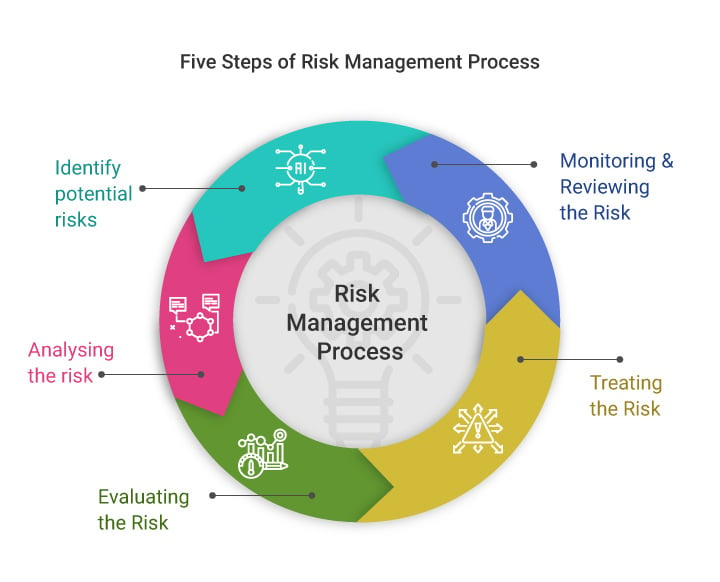
Organizations manage risks on a daily basis. The risk management process is one of the most important aspects of any company because it deals with the security of all the data present in the organization.
The highest priority for companies when it comes to risk management were stated to be the enhancement of the quality, availability, and timeliness of risk data at 79%, and the enhancement of risk information systems and technology infrastructure at 68%.
One can never be sure of the likeliness of any event to occur and the consequences that will come with it. The likelihood of the event occurring and the impact of the same event are two factors that determine the magnitude of the risk.
Table of Contents:
- What is the Risk Management Process?
- Need for Risk Management Process
- 5 Steps of a Risk Management Process
- Conclusion
Watch Methods to Manage and Avoid Risks
What is the Risk Management Process?
The Risk Management Process is a systematic approach to identifying, assessing, prioritizing, and managing potential risks that could affect the achievement of objectives within an organization or a specific project. It’s like a roadmap that helps you navigate the unpredictable terrain of business and increase your chances of success.
This structured process aims to enhance decision-making by systematically addressing uncertainties, allowing for proactive measures to mitigate risks and optimize the chances of success. The process is dynamic, iterative, and adaptable, ensuring that risk management strategies evolve in response to changing circumstances and new insights.
The risk management process typically includes steps such as:
- Identify the Risk
- Analyze the Risk
- Evaluate the Risk
- Treat the Risk
- Monitor and Review the Risk
Will explain each of these steps in the next section so that you get clarity about it.
Need for Risk Management Process
All project managers and team members need to learn how to implement necessary and systematic risk management processes. This will enable the entire organization to run their projects in a much smoother manner in the following ways:
- Improve all resource planning by predicting future costs
- Improve how companies track project costs
- Improve the accuracy of estimates of ROI
- A more flexible response to all future challenges
5 Steps of a Risk Management Process

The Risk Management Process is a systematic approach to handling uncertainties in a structured manner. These steps create a cyclical and adaptive process, allowing organizations to navigate uncertainties effectively and make informed decisions to enhance the likelihood of successful project outcomes. Let’s break down each step:
Step 1: Identify the Risk
The first step in a successful risk management process is to identify the type of risk the organization is currently dealing with or could deal with in the future. It is not merely a one-time activity but a continuous process that requires a thorough understanding of the project or organizational landscape.
This step involves engaging key stakeholders, conducting risk workshops, and employing various tools to systematically identify potential risks.
Risks can manifest in various forms, including external factors like economic shifts, internal factors like resource constraints, or project-specific risks such as technology failures or scope changes. Some of the different types of risks include:
- Strategic Risk: Associated with potential strategy failures, often due to external factors like market shifts or internal issues like poor decision-making
- Compliance Risk: Relates to potential violations of laws, regulations, or ethical standards, leading to legal actions, financial penalties, and reputational damage
- Market Risk: Arises from uncertainties in the market environment impacting financial performance, including changes in interest rates, currency fluctuations, or demand shifts
- Regulatory Risk: Involves potential negative impacts from changes in laws and regulations governing industry operations
- Operational Risk: Originates from internal processes, systems, people, or external events disrupting normal organizational functioning
It is important to identify all the different potential types of risks that the organization can face. These risks can be noted manually, but if a risk management platform is implemented in the organization, the risk identification process becomes much simpler.
The gathered information is directly inserted into the system. Access to this data also becomes a lot simpler because the project managers and other team members do not have to request an email for this information. They can directly log in to the risk management system and see all the identified risks.
Step 2: Analyze the Risk
All the possible risks for the organization have been identified in the previous step, which will lead the teams to analyze these risks. Once risks are identified, a detailed analysis is crucial for informed decision-making.
The risk analysis should answer the following questions:
- What is the likelihood of these risks occurring?
- What will be the consequences of these risks to the organization?
During the risk analysis process, teams estimate the probability of each risk occurring and its fallout to prioritize the identified risks. The factors that companies consider when prioritizing the risks include:
- Potential financial loss
- Time lost
- The severity of the impact
- Availability of resources to manage the risk
-Risk analysis helps companies create their response to these risks depending on their severity. It also helps in understanding the link between the risk and the number of aspects of the business it will affect. To put it simply, the more business aspects at risk, the higher the risk to an organization.
If companies use a manual risk management process, then this risk analysis takes place manually. Suppose a risk management solution is deployed across the organization. In that case, different documents, policies, processes, and procedures are analyzed by the solution to map the risk and create a framework for the next step, which is risk evaluation.
Step 3: Evaluate the Risk
Risk prioritization is a critical aspect of effective risk management, involving categorizing and ranking risks based on their severity. Many risk management solutions feature various risk categories; each assigned a rating corresponding to the potential harm they pose.
Risks causing minor inconveniences receive lower ratings, while those with the potential for catastrophic loss are rated the highest. Prioritizing risks is essential as it provides the organization with a comprehensive overview of its overall risk exposure.
While the business may face numerous low-level risks that don’t necessitate upper management intervention, a single high-rated risk can demand immediate attention.
There are two primary types of risk assessments: Qualitative Risk Assessment and Quantitative Risk Assessment.
-
Qualitative Risk Assessment
A qualitative risk assessment involves a comprehensive analysis of an event’s criticality by evaluating its probability of occurrence and its potential impact on the organization.
This method delves into the qualitative aspects of risks, seeking to understand the nature and severity of the event rather than assigning specific numerical values.
A qualitative risk assessment provides a nuanced understanding of the risk landscape by examining factors such as the likelihood of the event happening and the magnitude of its consequences.
It uses expert judgment, historical data, and contextual information to categorize risks into qualitative levels, such as low, medium, or high, allowing for a subjective yet informed prioritization.
-
Quantitative Risk Assessment
Quantitative risk assessment focuses on assigning numerical values to various aspects of the risk, primarily honing in on the financial impact or benefit associated with the event. This method seeks to quantify the potential monetary consequences of the risk, providing a precise and measurable representation.
Through statistical models, data analysis, and mathematical calculations, a quantitative risk assessment enables organizations to not only prioritize risks based on their financial implications but also to make data-driven decisions.
This approach is particularly beneficial when precise numerical data can be obtained, allowing for a more objective and quantitative evaluation of the risk event.
Step 4: Treat the Risk
Once the risks have been analyzed and prioritized, it is time to take action. Every risk to the organization or the project must either be eliminated or contained. If the risk treatment is done manually, team members must contact each stakeholder to discuss the issues.
Usually, these discussions get spread out over email chains, various documents, and many phone calls, making the entire process longer and more difficult.
When companies employ a risk management solution, the stakeholders are immediately notified by the application, and all the key decisions are made in one go. This way it becomes easy to monitor the progress of the solution.
One aspect of effectively treating the risk is using resources without losing the progress made in the active projects. Over time, organizations can create a log of all the projects, the risks faced, and the mitigation process.
This will help anticipate future risks so that the team members can be proactive in their risk management strategy. Depending on the nature of the risk, a response strategy is defined for the project. The following seven strategies are possible:
- Accept: Refrain from taking any proactive measures and instead maintain vigilant monitoring.
- Mitigate/Enhance: Decrease (for a risk) or increase (for an opportunity) the likelihood of occurrence and the magnitude of impact
- Transfer/Share: Shift the responsibility for a risk to a third party, which would assume the consequences of the issue (or share the benefits of a seized opportunity)
- Avoid/Exploit: Eliminate uncertainty or capitalize on the opportunity
Step 5: Monitor and Review the Risk
Organizations will notice over time that there will be some risks that cannot be eliminated and will be omnipresent. These continuous risks can include external risks such as market risks and environmental risks. They need to be continuously monitored to make the mitigation process more effective.
When companies employ risk management solutions, the system becomes responsible for monitoring the organization’s complete risk framework. If there is any change, all relevant parties get notified immediately. This also ensures continuity. When employees are properly trained in the processes, they can use the system efficiently.
Conclusion
The Risk Management Process forms a crucial blueprint for organizations to effectively navigate uncertainties in their project. From the initial identification of risks to the continuous monitoring and adaptation in the face of evolving circumstances, this systematic approach ensures a proactive and strategic response to potential threats and opportunities.
If your company has a good plan and a culture that is aware of risks, it will easily handle any crisis or big change.
Are you ready to find out how to make your risk management process frictionless? Look no further! Invensis Learning presents an enriching Project Management Certification Courses designed to equip you with the knowledge and tools needed to excel in the dynamic world of project execution.
















